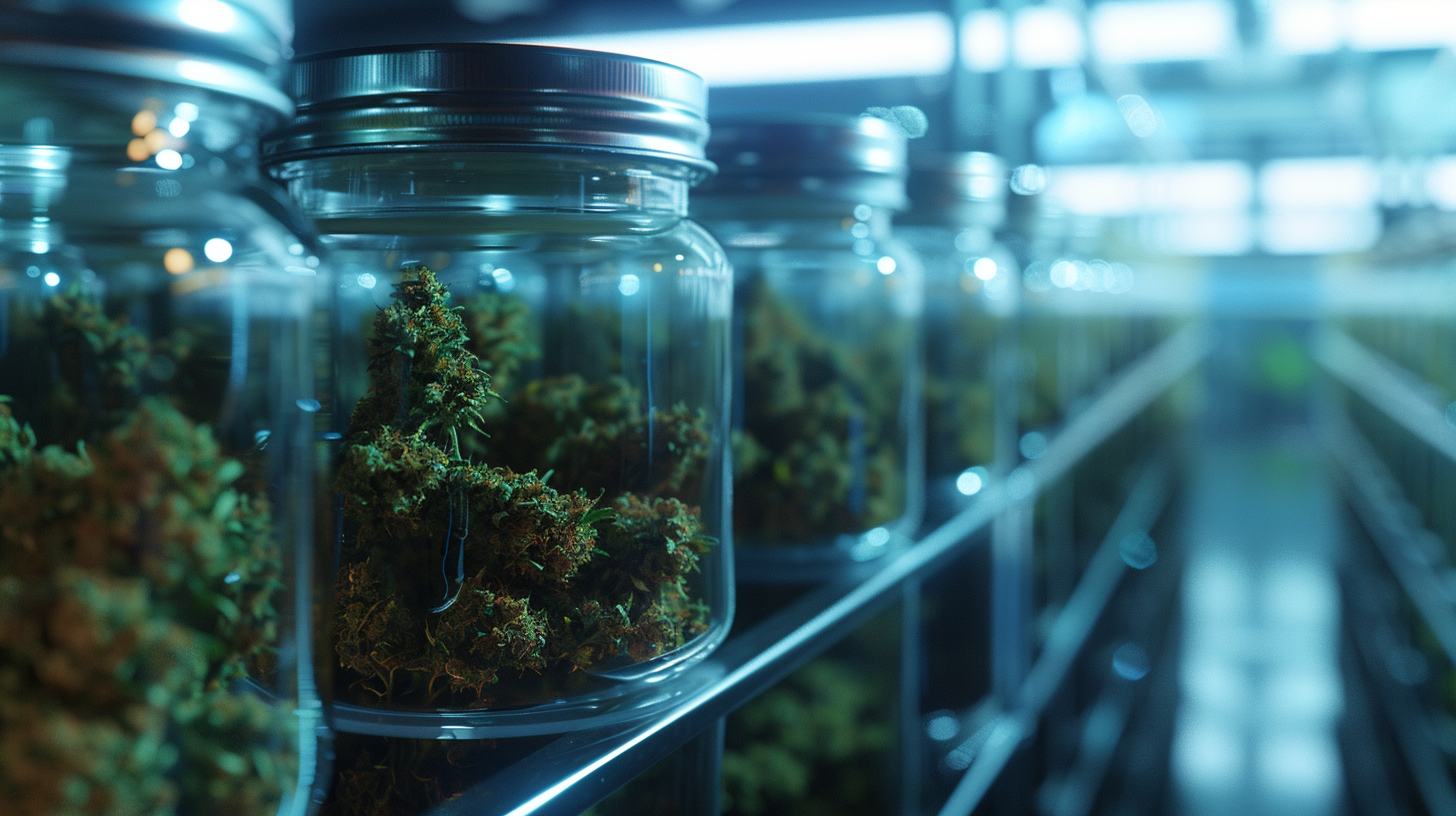Most cannabis growers overlook container selection, yet the right pots can determine your growing success or failure.
Many growers meticulously plan their nutrients, lights, and soil but miss this significant detail. The size and material of your containers directly shape your cannabis growth. A 3-gallon pot in the USA holds less volume than advertised, which can limit your plants’ development.
Your plants require roughly 1 gallon of pot space per foot of growth. Flowering plants need an extra gallon. The last several years have brought state-of-the-art solutions like fabric pots. These enhance air exchange and drainage to create healthier root systems.
This piece offers a detailed look at container selection for cannabis plants. You’ll learn the best materials and sizes to use. The information helps you sidestep common growing mistakes and maximize your results.

Why Pot Choice Matters for Cannabis Growth
Pot selection plays a key role in how cannabis plants develop and thrive. My years of growing experience show that pot choice affects everything from root health to final harvest quality.
How pots affect plant health
Root health starts with the right pot choice. Research shows doubling a pot’s size leads to 43% more biomass production [1]. Healthy roots make up almost half of a plant’s anatomy [2].
Different pot materials have unique effects on root development. Fabric pots help prevent waterlogged roots – a common threat to cannabis health [2]. On top of that, they promote air pruning that gets more lateral root growth and stops roots from circling.
My growing experience shows plastic containers are budget-friendly but can cause root binding problems. Clay pots let moisture evaporate and help prevent overwatering. Air pots bring the latest technology with improved aeration for better root development.
Container size directly impacts cannabis growthTrue
The right container size is essential for healthy root development, which leads to stronger and higher-yielding plants.
Plastic pots provide the best root air circulation.False.False
Plastic pots are affordable but restrict airflow to the roots, leading to potential root-binding issues.
Impact on yields
Pot size has a direct and measurable connection to cannabis yields. Studies confirm that bigger pots give roots more space to grow, and this gets more growth above ground [3].
Indoor growing works best with 11-liter pots that let plants reach about 90cm [3]. All the same, bigger isn’t always better. Plants in larger pots need more water, nutrients, light and space to grow properly.

The sort of thing I love from my growing tests lines up with research – growers using fabric pots get higher yields than those using plastic ones [2]. More importantly, a plant’s biomass determines the right pot size – research suggests using no more than 1 gram of plant material per liter of pot volume [1].
Types of Pots You Can Use
My years of growing cannabis have taught me a lot about different pot types. Each one brings something special to the table. Let me walk you through what works best based on my hands-on experience.
Plastic pots: Pros and cons
Plastic pots are a go-to choice because they’re affordable – you can get a 1-gallon pot for less than $1 [4]. These pots create a solid barrier that helps roots form a strong network throughout the growing medium. The downside? They don’t breathe well, and you only get air flow from the drainage holes at the bottom [4].
Fabric pots: What to know
The 1980s brought us fabric pots, and they changed the game for cannabis growing [5]. These pots have thousands of tiny holes that let air and water flow freely [6]. My grows have shown that fabric pots stop water from pooling and help roots grow better through air pruning. The roots stop growing when they hit the pot’s edge and branch out sideways instead [7].

Clay pots: Good or bad
Clay pots take us way back to 575 BC, and they’re great at letting air through and keeping temperatures steady [5]. My tests show their breathable nature keeps roots happy. The catch? They weigh a ton once you add soil, and they’ll crack if you drop them [8].
Air pots: Latest technology
Air pots are the newest breakthroughs in cannabis growing. You’ll find hundreds of holes along their sides and bottom [6]. These holes create a perfect setup where roots get oxygen from every angle throughout the growing cycle. The design stops roots from getting bound up and helps them grow in an organized way [6]. Studies from Holland and Germany show plants in Air-Pot systems grow 75% faster than traditional methods [9].
Pick the Right Pot Size
Pot sizing is vital to successful cannabis cultivation. My growing experience shows that the right container size at each growth stage significantly affects plant development and final yields.
Starting size for seedlings
Seedlings thrive in small containers that help develop strong root systems. I start my plants in 4-inch or 1-gallon pots during germination [10]. This size works best because young plants need minimal root space and it helps prevent overwatering.
Small containers give better control over moisture levels in these early stages. Seedlings show they’re ready for larger pots after developing 4-5 sets of leaves [10]. My experience shows that cannabis needs 2 gallons of soil for every 12 inches of growth during the vegetative stage [10].
Fabric pots help prevent waterlogged rootsTrue
Fabric pots allow air to circulate around the roots, preventing waterlogging and promoting air pruning for healthier roots.
Larger pots always result in higher cannabis yields.False.False
While larger pots provide more root space, they also require more water, nutrients, and light, which can complicate the growing process.
When to size up
The right moment to transfer plants to bigger pots can make all the difference in their growth. These signs tell you it’s time to size up:
-
Leaves crowding or overlapping
-
Roots growing out of drainage holes
-
Plant height exceeding container height [11]
I always give plants at least double the space of their previous container when transplanting [10]. This means moving from a 1-gallon to a 2-gallon, then to a 5-gallon pot [10].
Plants placed in oversized pots too early won’t stretch their roots properly and might struggle to absorb water efficiently [10]. Through trial and error, I’ve found that transplanting 1-3 times during the growing cycle with gradually increasing pot sizes produces the best results [10].
Outdoor growing needs larger containers naturally. Research backs up my experience that a healthy cannabis plant’s canopy can grow to three times the diameter of the pot [12]. This helps plan space requirements and maximize yields effectively.

Match Pots to Your Growing Space
Space plays a vital role in picking the right containers for cannabis cultivation. My years of experimenting with different growing environments taught me that matching pots to your space determines plant health and success.
Indoor growing needs
You just need to pay attention to container selection when growing cannabis indoors. We used every square foot of indoor space efficiently. Square pots hold more soil than round ones of the same size [13], which makes them perfect for limited indoor space.
Height matters substantially in indoor setups. Plants prefer taller pots because they create a drier root environment [14]. I stay away from shallow containers that hold too much moisture. My pots have strategic holes at both the base and sides [14] to drain properly.
There’s another reason people miss in indoor growing: drainage affects humidity levels. Water that collects can raise moisture in enclosed spaces and lead to mold in flowers [14]. I learned to feed plants only when needed while keeping a drier growing environment.
Outdoor considerations
Growing cannabis outdoors comes with its own challenges and opportunities. You don’t need as much equipment as indoor cultivation because sunlight and fresh air naturally give you the right environment [15].
Protection from elements becomes vital when growing on balconies or terraces. I found that there was a need for at least 5-6 hours of uninterrupted sunlight daily [16]. Plants also need shelter from heavy rain and strong winds.
Security and mobility are top priorities in outdoor growing. Larger containers like 35-gallon pots work well for bigger plants [15], whatever you’re growing on a balcony or in a garden. Here’s how to improve security:
-
Use visual barriers like other plants or furniture
-
Make sure there are no easy access routes to your growing area
-
Think over autoflowering varieties for their smaller size and discretion
Container growing outdoors gives you one advantage: knowing how to move plants when needed. This flexibility is a great way to get through bad weather or protect flowers from mold at the end of growing season [5].
Common Pot Problems and Fixes
Growing cannabis requires skill in handling container-related problems. My years of growing have taught me how to solve many pot-related challenges that hurt plant health and yields.

Drainage issues
Bad drainage hurts root health and stops nutrients from reaching the plant. My first attempts with garden soil in containers led to waterlogging, yellow leaves, and slow growth [17]. A switch to specialized potting mix designed for containers solved these problems.
Many growers believe adding gravel at the bottom of pots helps drainage. Research proves this creates a perched water table where water sits in the soil above the gravel [18]. The roots end up waterlogged instead of well-drained.
These methods have worked well to improve container drainage:
-
Adding perlite to increase porosity
-
Using containers with multiple drainage holes
-
Keeping soil moisture right without overwatering
Root binding
Plants show root binding when their roots outgrow the container space and form a dense, tangled mass. You can spot these warning signs:
-
Stunted growth and drooping leaves
-
Soil dries out very quickly
-
Roots circle visibly at the pot’s bottom [19]
Moving the plant to a larger container fixes this issue. The best time to transplant is 1-2 days after watering [19]. The root ball needs gentle loosening after removal to help roots grow outward in the new container.
Temperature control
Root health and plant growth depend heavily on temperature. Cannabis plants grow best in temperatures between 70-85°F (20-30°C) during light hours [3]. Temperatures above 80°F (26°C) during flowering slow bud growth and can make buds loose and airy [3].
Years of testing have helped me develop good temperature control methods. Plants can handle temperatures up to 85°F (30°C) with proper air movement when using high-intensity lights [3]. Lower temperatures during dark periods help plants grow faster [3].
Good airflow around containers helps maintain the right root zone temperature. Fabric pots and air pots work great because their design allows better temperature control through evaporative cooling. Outdoor growers should place pots in partial shade during the hottest hours to protect roots from big temperature swings.
Conclusion
My years of cannabis growing experience have taught me that the right pots significantly impact your success. Quality containers create healthy roots that produce bigger yields and healthier plants.
I’ve tested various pot types, and each has unique advantages. Plastic pots are perfect for beginners and budget-friendly. Fabric pots enhance root airflow effectively. Air pots represent cutting-edge technology, while clay pots naturally regulate temperature.
Your seedlings need small containers initially, with gradual size increases as they develop. This simple approach helps avoid common growing issues. The growing environment should guide your pot selection – indoor and outdoor spaces need different solutions.
Drainage, root binding, and temperature control can determine your growing success. Early attention to these factors eliminates problems before they affect the growing cycle.
Successful cannabis growing depends on mastering these simple fundamentals. The right container choice, consistent monitoring, and timely adjustments will reward you with thriving plants and improved yields.
References
- Pot size matters: a meta-analysis of the effects of rooting volume on plant growth
- How fabric pots increase cannabis yields
- Temperature for cannabis growth
- Plastic pots vs fabric pots: The right pot for cannabis
- Types of containers for growing weed
- Can air pots and smart pots increase cannabis yield?
- Fabric pots: Pros and cons
- The best pots to grow cannabis
- Airpot
- How to transplant cannabis plants
- Cannabis transplanting 101
- How and when to transplant your weed
- Best grow pots for cannabis
- Growing cannabis in the right containers
- Best outdoor grow setup
- Cannabis cultivation on the balcony: A practical guide
- Ways to improve drainage for plant pots
- How to improve drainage in plant pots
- How to prevent and fix root bound cannabis




